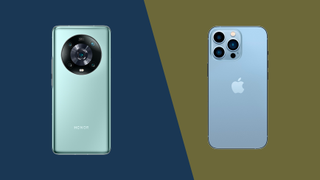
Now that Honor has broken free of the shackles of its parent company, Huawei, it’s ready to take on Apple in the flagship phone market.
Make no mistake, the Honor Magic 4 Pro is a big hitter with the chops to take on the best that Apple, Samsung, and Xiaomi have to offer.
We’re not ready to offer our full review of the Honor Magic 4 Pro just yet, but we did get some hands-on time back at MWC 2022, and we have the phone’s specs. Here’s an in-depth spec comparison to the iPhone 13 Pro Max, which is the elder statesman of the premium flagship scene.
iPhone 13 Pro Max vs Honor Magic 4 Pro price and availability
The iPhone 13 Pro Max was released on September 24, 2021. Prices start from $1,099 / £1,049 / AU$1,699 for the 128GB model, while $1,199 / £1,149 / AU$1,869 will get you 256GB, and $1,399 / £1,349 / AU$2,219 will secure the 512GB model.
There’s also a 1TB model this time around, which will cost $1,599 / £1,549 / AU$2,569.
The Honor Magic 4 Pro is launching globally on May 12, 2022. We don’t know exactly when we’ll be able to buy the phone, but we do know that prices are set to start at $899, which works out to around £1,200 / AUS $1,650.

Design
The iPhone 13 Pro Max looks a lot like the iPhone 12 Pro Max from late 2020. It’s all flat surfaces and sharp corners, with a premium surgical-grade stainless steel rim.
While this aggressive styling looked good, it did tend to dig into the palms somewhat. Part of that is down to its sheer size, which is a considerable 160.8 x 78.1 x 7.65mm, and its 238g weight.
By contrast, the Honor Magic 4 Pro adopts a much curvier Android flagship design. From our own hands-on, we found it to be a premium bit of kit – curved glass to front and back, sandwiching polished metal.
It’s not a small phone by any means. At 163.6 x 74.7 x 9.1mm it’s taller and thicker than even the iPhone 13 Pro Max, but it’s also narrower thanks to the lack of bezels on the side. It’s quite a bit lighter too at 215g.
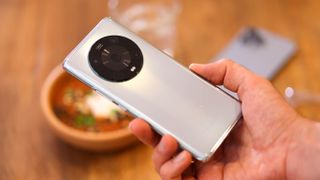
The rear of Honor’s phone sees an evolution of the Honor Magic 3, with a large circular camera module. What’s striking is the way the periscope camera is positioned right in the center.
In terms of colors, the iPhone 13 Pro Max comes in Graphite, Gold, Silver and Sierra Blue. The Honor Magic 4 Pro will come in Black, Cyan, Gold, White, and Orange.
The iPhone 13 Pro Max has a prominent notch. Apple has reduced it in size by 20%, but it’s still quite hefty. The Honor Magic 4 Pro meanwhile uses a large camera cut-out instead.
The company is a rare Android manufacturer that emulates Apple’s Face ID system for secure biometric authentication, and we love it for that.
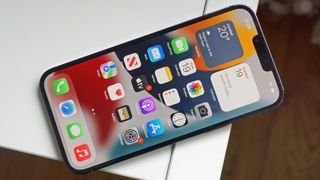
Display
Both of these phones have great-looking displays and appear to be quite closely matched.
At 6.8 inches, the Honor screen is fractionally larger than the 6.7-inch iPhone equivalent. A resolution of 2848 x 1312 for the Honor is very close to the iPhone 13 Pro Max’s 2778 x 1284. The pixel density is almost identical between the two.
Both phones use LTPO technology and can extend to a maximum 120Hz refresh rate. But while the iPhone 13 Pro Max can drop to 10Hz in certain conditions, the Honor Magic 4 Pro can go all the way to 1Hz. It’s potentially more efficient as a result.
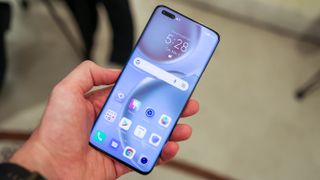
Honor has also upped its screen’s flicker rate to 1,920Hz, which purportedly makes it look smoother in dim lighting conditions. Certainly more than the iPhone, which peaks at 480Hz. We’ll have to test if these claims bear out, of course.
We’ll have to hold off judgment until we’ve used the Honor for an extended period, but it would appear to have a slight edge in the display department.
Cameras
The iPhone 13 Pro Max provides a superb triple–12MP camera system, led by a new larger wide sensor and a large f/1.5 aperture. This is accompanied by a 12MP ultra-wide with a new macro function, allowing you to get as close as 2cm away from your subject.
On the telephoto front you get a 3X zoom, which is now capable of shooting in Night Mode.
As for the Honor Magic 4 Pro, there’s a 50MP wide sensor with an f/1.8 aperture, a 50 MP ultra-wide, and a 64MP periscope telephoto that can extend to a 3.5x optical zoom. Oh, and a TOF 3D depth sensor for good measure.
Again, we’ll need some serious hands-on time to test whether Honor has managed to top the iPhone here. On paper, it seems to have the more impressive specs, though the iPhone has a more advanced sensor-shift OIS system for potentially steadier low light shots.

Of course, Apple’s photography supremacy has never been (entirely) about the hardware specs. It’s won its position through superb image processing and pleasingly natural color science. You can be confident that what you shoot will come out more or less how it looked.
The iPhone 13 Pro Max also features new Photographic Styles, which let you change the basic tone and warmth of your shots without ruining the balance.
You also get Smart HDR 4, which can make HDR adjustments for multiple people within a scene.
For its part, Honor appears to be making much of its phone’s enhanced AI algorithms, as well as the ability of that impressive periscope lens to produce up to 100X hybrid zoom shots. Judging by previous Huawei/Honor phones, it’ll give the likes of the Samsung Galaxy S22 Ultra a run for its money on that front.
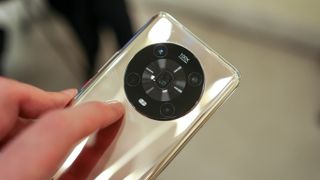
The iPhone 13 Pro Max is pretty much the best phone for video capture right now, with crisp and balanced 4K footage at 60fps. The new Cinematic mode automatically refocused according to a subject’s gaze, and can even predict when a subject is about to come into view. Meanwhile, ProRes mode lets you record, edit, and deliver broadcast-ready content on the go at 4K/30fps.
Honor has made its own video advances with the Magic 4 Pro, however. It features industry-first 10-bit Log 4K video recording in 60fps, while Magic-Log pro mode apparently preserves more original detail and dynamic range information.
Both phones feature 12MP selfie cameras accompanied by depth sensors, so it’ll be interesting to compare their selfie portraits.
Specs and performance
While we’re holding off judgment in every other regard, we feel confident in saying the iPhone 13 Pro Max has the performance edge over the Honor Magic 4 Pro.
That’s because Apple’s custom A15 Bionic has been proven to be considerably more capable than the off-the-shelf Snapdragon 8 Gen 1 chip that powers the Honor phone. We’ve run the benchmark tests ourselves with the first batch of 2022 flagship Android phones.
Apple boasted at the time of launch that the A15’s 6-core CPU and 5-core GPU are around 50% faster than the leading competition on the Android side. We found that the iPhone 13 Pro Max was almost twice as fast as some of its contemporaries in ways such as frame rate, multi-core capability, and video transcoding speed.
Of course, with the iPhone launching late last year, this is all in relation to the previous-generation Snapdragon 888 chip. But while the Snapdragon 8 Gen 1 has undoubtedly closed that gap somewhat, it’s only done so by 20-30% by some metrics.
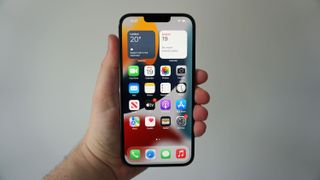
In practical terms, of course, these two phones will likely be indistinguishable. Both will run games and high-intensity tasks extremely fluidly.
In storage terms, the iPhone 13 Pro Max gives you a choice of 128GB, 256GB, or 512GB of internal capacity, as well as a top 1TB option. The Honor gives you a choice of 256GB or 512GB.
One of the most interesting areas for Honor will be its software. The company is free of the restrictions levied on its former parent company, Huawei, which means that it can support Google apps and (crucially) the Google Play Store.
But this is still Magic UI, which shares much with Huawei’s own EMUI. This is traditionally a rather heavy, in-your-face Android skin with a little too much bloatware. Compared to Apple’s pure iOS, it historically feels like hard work.
We’ll have to wait for a proper hands-on before we can judge whether there have been any significant improvements here.
Battery
It’s been confirmed (unofficially) that the iPhone 13 Pro Max has a 4,352mAh battery. That’s not all that big for an Android device, but it’s huge for an iPhone, with iOS traditionally being the more efficient operating system.
Apple claims that the iPhone 13 Pro Max will get 1.5 hours more out of a charge than its predecessor. We can back that up, finding it to have the best battery life ever from an iPhone.
That amounted to a third of a tank full at the end of an intensive day’s use.
We’ll have to wait and see if the Honor Magic 4 Pro can match or even exceed that. Honor is going to have to pull some smart battery-saving tricks if so, because at 4,600mAh, the cell is only slightly bigger than its rival’s.
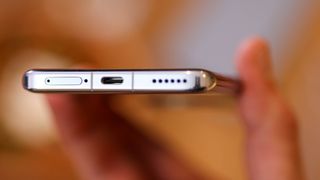
One way in which the Honor will blitz the iPhone is when it comes to recharging. Honor’s 100W Wireless SuperCharge system can apparently recharge the phone to 50% battery in 15 minutes, and this is bundled in with the phone.
By contrast, the iPhone 13 Pro Max only supports up to 20W, and you don’t even get that charger in the box. When you do get your hands on a charger, we found that in 15 minutes we could replenish the phone to a third full.
Impressively, the Honor also supports rapid 100W wireless charging, while the iPhone only supports up to 15W wireless charging.
Takeaway
The Honor Magic 4 Pro seems to suggest that Honor is taking over where Huawei left off in terms of eye-catching specs and sleek flagship designs.
This looks to be another impressive Android flagship, with competitive power, an impressive camera system (especially in the zoom stakes), and rapid 100W charging.
Of course, Apple has some formidable advantages that Honor will have to contend with. The iPhone 13 Pro Max is arguably the best camera phone on the market right now, capable of taking reliably sharp and balanced shots in virtually all conditions.
It’s also the undisputed performance king, with no Android rival getting anywhere close for sheer processing power. Apple’s clean iOS software historically compares well to Honor’s/Huawei’s cluttered efforts too.
With its Huawei heritage, though, we’re hopeful that Honor can give the iPhone 13 Pro Max some serious competition at the top of the smartphone tree.
- Not convinced by either? Check out all the best smartphones
Get daily insight, inspiration and deals in your inbox
Get the hottest deals available in your inbox plus news, reviews, opinion, analysis and more from the TechRadar team.
